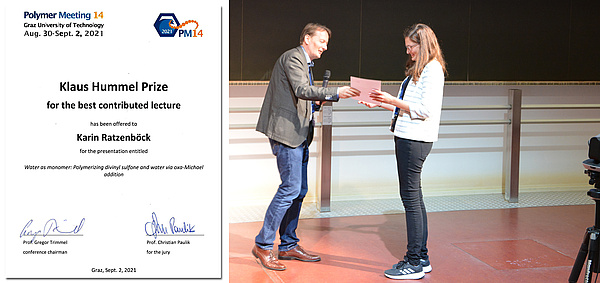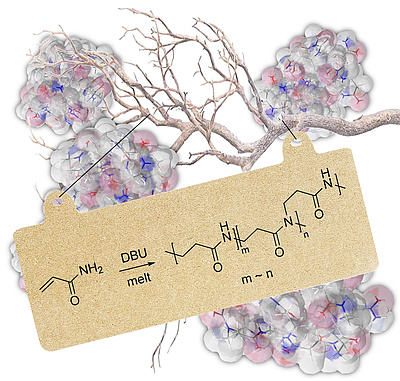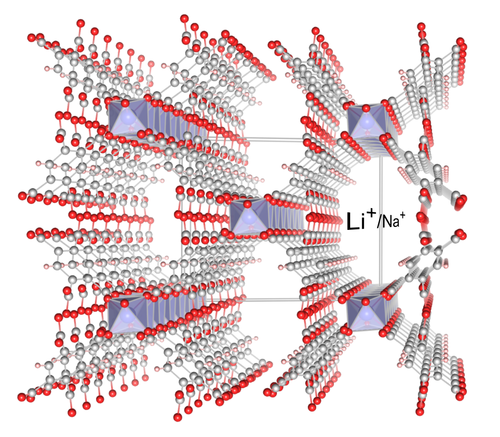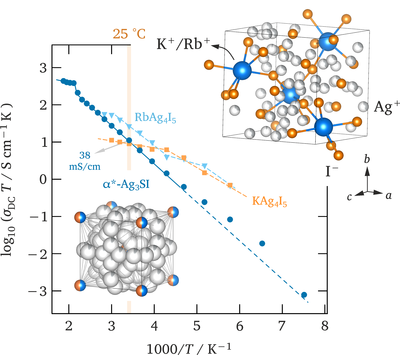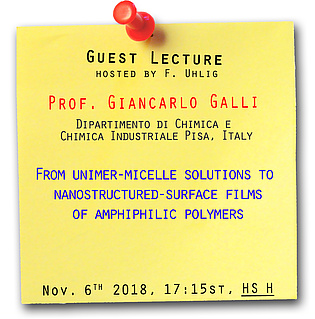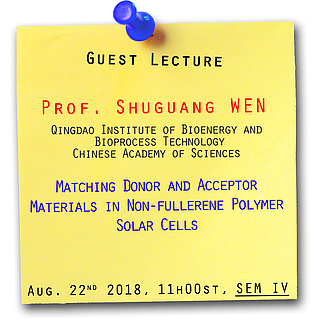
 Ions on the fast track: Interfacial regions in nanocomposites
Ions on the fast track: Interfacial regions in nanocomposites
Interfacial regions between liquids and solids provide fast diffusion paythways for small cations such as lithium. Check out the results we obtained on ionic-liquid-in-salt composites. The effect is only seen with long-time NMR relaxation measurements. Link to the the paper in ACS Phys. Chem. AU.
 Porphyrin based MOFs: Quasi matrix-free optical oxygen sensor materials with exceptional sensitivity in the gas phase
Porphyrin based MOFs: Quasi matrix-free optical oxygen sensor materials with exceptional sensitivity in the gas phase
Researchers from the Instuitute of Analytical Chemistry and Food Chemistry and ICTM (in the framework of the lead project Porous Materials@Work) demonstrated in their recent paper in Journal of Materials Chemistry C that properly designed metal-organic frameworks are particularly useful to exploit the full potential of oxygen sensitive luminescent indicator dyes. By studying the optical oxygen sensing capabilities of the porphyrin-based metal-organic frameworks, PCN-224, Pt(II)PCN-224 and Pd(II)PCN-224 in the gas phase particularly high bimolecular quenching constants were found. The high sensitivity of the MOF crystals is above all attributed to the fact that they are luminescent in bulk, i.e. dye molecules do not quench each other when confined in the investigated MOF architecture. Accordingly, no matrix, which usually reduces the sensitivity, is necessary to separate the dye molecules. In order to take full advantage of such quasi matrix free oxygen sensor crystals in building optical oxygen sensors the researchers demonstrated a composite material that was prepared by growing the MOFs on fibrous substrates. Among the all substrates investigated electrospun polyacrylonitrile fibers proved to be the best support giving sensor pads of very similar sensoric characteristics as the free crystals. (cs)
 Review in the field of organic solar cells
Review in the field of organic solar cells
Organic solar cells are on the dawn of the next era. The change of focus toward non-fullerene acceptors has introduced an enormous amount of organic n-type materials and has drastically increased the power conversion efficiencies of organic photovoltaics, now exceeding 18%, a value that was believed to be unreachable some years ago. The Trimmel group under the lead of Thomas Rath and Matiss Reinfelds summarizes the recent progress in the design of ladder-type fused-ring non-fullerene acceptors in the years 2018–2020 in their latest review published in ACS Applied Energy Materials. They concentrate on single layer heterojunction solar cells and omit tandem architectures as well as ternary solar cells. By analyzing more than 700 structures, the basic design principles and their influence on the optical and electrical structure of the acceptor molecules are highlighted and their photovoltaic performance obtained so far is reviewed. The article should give an extensive overview of the plenitude of acceptor motifs but will also help to understand which structures and strategies are beneficial for designing materials for highly efficient non-fullerene organic solar cells. (cs)
 Materials for Optical Oxygen Sensing under High Hydrostatic Pressure
Materials for Optical Oxygen Sensing under High Hydrostatic Pressure
In order to provide optical trace oxygen sensors useful for investigating oxygen minimum zones in the oceans, optical oxygen sensors based on indicators immobilized into porous and nonporous matrix materials were investigated in regard to their sensing behavior under high hydrostatic pressure. Researchers from Porous Materials@Work found in their latest paper in Sensors and Actuators B: Chemical a systematic underestimation of oxygen concentration at elevated hydrostatic pressure and a linear correlation of the concentration on hydrostatic pressure in the investigated range allowing for a straightforward correction. Most importantly, the investigated porous sensor materials show high stability up to at least 200 bar hydrostatic pressure. This result constitutes an important information for the realization of commercially available optical trace oxygen sensors. (cs)
 Fuzzy Logic: Origins of Fast Ion Displacements in Solids
Fuzzy Logic: Origins of Fast Ion Displacements in Solids
Review about the origins of ion dynamics in solids. Which parameters affect Li ion dynamics the most? We think it is cation disorder on partially filled sublattices leading to the loss of site preferences (in former times simply called: lots of point defects ;- ) ) as well as dimensionality and interfacial effects. To a certain degree also rotational jump processes will contribute. Of course, the right polyhedra connection is always neccessay to enbale long-range ion transport. Full paper appeared in Phil. Trans. A of the RSC. Thank you all, who helped me over the past years, hmr.
 PM14 successfully organized
PM14 successfully organized
Under the lead of Gregor Trimmel, ICTM successfully organized the Polymer Meeting 14 at the TU Graz from Aug. 30 to Sept., 2021. About 180 participants listened to 34 invited and 62 contributed lectures and discussed 53 poster presentations. Furthermore, a public lecture on plastics sustainability was broadcasted for the public and stimulated fruitful discussions. All in all the participants were happy to have experienced a step back to normal scientific culture in these unusual times. Visit the PM14 homepage for a look back on the event. (cs)
 Klaus Hummel Prize to Karin Ratzenböck
Klaus Hummel Prize to Karin Ratzenböck
In memoriam of Prof. Klaus Hummel, who passed away on May 15, 2021 the Klaus Hummel Prize was established and awarded for the most outstanding contributed lecture within the Polymer Meeting 14 recently held in Graz. To our great pleasure, the first Klaus Hummel Prize was offered to Karin Ratzenböck for her contribution "Water as monomer: Polymerizing divinyl sulfone and water via oxa-Michael addition". Moreover, this is also a great achievement for the CD-laboratory Organocatalysis in Polymerization and its collaboration partners. (cs)
 Electron-rich triarylphosphines as nucleophilic catalysts for oxa-Michael reactions
Electron-rich triarylphosphines as nucleophilic catalysts for oxa-Michael reactions
Susanne M. Fischer from the Slugovc-group reports in a collaboration with Daniel A. Boese (Univ. of Graz) the scope of three electronically different triarylphosphine in initiating oxa-Michael additions. A matrix consisting of three differently strong Michael acceptors and four alcohols of varying acidity was used to assess the activity of the three pre-catalysts, namely 4-(methoxyphenyl)diphenylphosphine (MMTPP), tris(4-trimethoxyphenyl)phosphine (TMTPP) and commonly used triphenylphosphine (TPP). The results reveal a decisive superiority of TMTPP for converting poor and intermediate Michael acceptors such as acrylamide and acrylonitrile and for converting less acidic alcohols like isopropanol. With stronger Michael acceptors and more acidic alcohols, the impact of the more electron-rich catalysts is less pronounced. The experimental activity trend was rationalized by calculating the Michael acceptor affinities of all phosphine–Michael acceptor combinations. Besides this parameter, the acidity of the alcohol has a strong impact on the reaction speed. Furthermore, the oxidation stability of the phosphines was evaluated and the most electron-rich TMTPP was found to be only slightly more sensitive to oxidation than TPP. (cs)
 Interfacial Transport in Composites
Interfacial Transport in Composites
Thanks to our great collaboration with Petra de Jongh's group in Utrecht, Roman managed to characterize the interfacial Li ion transport in nanoconfined LiBH4-alumina. The results will appear next week in J. Phys. Chem. C including our first bond valence estimation carried out by Katharina.
 Chemical recycling of natural rubber waste
Chemical recycling of natural rubber waste
The latest work of Viktor Schallert from the Slugovc group just appeared in Macromolecular Chemistry and Physics. The team disclosed the use of a surfactant derived from the degradation of natural rubber gloves via cross‐metathesis with methyl acrylate and subsequent saponification of the ester group for the stabilization of water in dicyclopentadiene high internal phase emulsions. The versatility of the resulting high internal phase emulsion is demonstrated by polymerizing the continuous dicyclopentadiene phase via ring‐opening metathesis polymerization yielding macroporous poly(dicyclopentadiene) foams with a porosity of 82%. The use of the ionic surfactant allows for the preparation of foams, which are resistant to absorb water. This property is hitherto not accessible with protocols involving the use of nonionic surfactants commonly employed in emulsion templating of polymers. (cs)
 Look inside: MOFs
Look inside: MOFs
Good to see Ilie Hanzu's work on ion-conducting MOFs on the inside front cover of Advanced Energy Materials. Thanks to Mr. Garger from TU Graz for his help!
 Vacant PhD positions in battery research
Vacant PhD positions in battery research
In the Wilkening/Hanzu group there are several PhD positions available (30 h/week, 40 h/week). Additionally, we are seeking for a motivated candidate to fill a so-called 'University Assistent' PhD position (40 h/week), most likely starting from June/July 2021 or September 2021.
Topics: (Mechano-)synthesis and spectroscopic characterization of new solid electrolytes (dynamics in ceramics) for, e.g., fluorine-based batteries; in situ lithium NMR; ageing mechanisms in all-solid-state batteries; microcontact impedance spectroscopy to understand macroscopic transport in Li/Na-based batteries; interfacial properties of thiophosphate-based Li-sulfur batteries.
Feel free to contact us by e-mail.
 Highly branched polyamide 3 by melt polymerization
Highly branched polyamide 3 by melt polymerization
The Christian Doppler Laboratory of Organocatalysis in Polymerization together with collaborators from Ljubljana and Graz introduced an easy, resource-efficient and green protocol to prepare polyamide 3 (PA 3) featuring a branching point at approximately every second repeat unit. The key for obtaining this unprecedented polymer is using nucleophiles as initiators for the aza-Michael polymerization of acrylamide. The reaction is carried out in the melt of acrylamide, and solvents are neither involved in the preparation nor during workup. DBU is particularly suited as the initiator and a loading of only 0.5 mol% is sufficient for complete consumption of the monomer. The resulting branched PA 3 is fully amorphous and is characterized by a molar mass of about 23.4 kg/mol, a glass transition temperature of 67 °C and a high solubility in water and DMSO. These properties make branched PA 3 interesting for applications in biological and biomedical systems. For more details see the article published in ACS Applied Polymer Materials. (cs)
 MOFs and Ionic Conduction
MOFs and Ionic Conduction
Roman Zettl and Ilie Hanzu managed to functionalize the MOF MIL-121 in such a way that Li and Na ions can easily be transported along the inner channels of the host framework. A conductivity of 0.1 mS/cm for Na (298 K) is an amazing value that opens up new perspectives in ion-conducting MOFs. The results appeared in Wiley's Adv. Energy Mater.
Of course, NMR helped characterizing the transport process and confirmed that Li is the relevant charge carrier (and not H). Interesting to see a transition from correlated to uncorrelated motion as it is also supposed to be present in closo-borates and Na-beta''-alumina.
 Fast Ag+ diffusion in antiperovskite-type Ag3SI
Fast Ag+ diffusion in antiperovskite-type Ag3SI
Maria Gombotz (AGW) succeded in preparing Ag3SI, being a known but fantastic model substance to study Ag+ dynamics in a complex energy landscape, 38 mS/cm at 298 K. Let's see whether we will manage to record 109Ag NMR spectra. Publication will soon appear in Solid State Sciences.
 Interlayer Diffusion in Li3N single crystals
Interlayer Diffusion in Li3N single crystals
The reliable measurement of Li ion jump rates is necessary to validate theoretical approaches to study self-diffusion processes in crystalline solids. Here, we used Li(7) evolution-time resolved spin-alignment echo NMR to precisely determine the interlayer Li cation hopping rate in lithium nitride single crystals. The exchange rate obtained perfectly agrees with those deduced from other NMR methods including Li(8) beta-radiation detected NMR and data from theory. Link to the paper: Eur. J. Inorg. Chem. (special issue of the ADUC prize winners of the GdCh)
 Spin-Alignment Echo NMR: Li Jump Rates in Li4SnS4
Spin-Alignment Echo NMR: Li Jump Rates in Li4SnS4
Back to the roots. Katharina managed to directly measure Li exchange rates in a series of sulfides and selenides via so-called stimulated echo NMR spectroscopy. Results appeared in J. Phys. Chem. C. Such measurements yield not only activation energies and jump rates but also the attempt frequencies that are relevant for the Li hopping processes. These frequencies determine the Arrhenius pre-factor governing the main diffusion path.
 "2D substitution" in solid electrolytes
"2D substitution" in solid electrolytes
Together with the Zeier group at WWU we managed to characterize ion dynamics in a series of sulfides and selenides to understand the origins behind ionic transport in potential solid electrolytes for batteries. Congratulations Katharina; the subsequent stimulated echo NMR study is on its way. It is our second paper in 2021. Further reading: Two-Dimensional Substitution: Toward a Better Understanding of the Structure –Transport Correlations in the Li-Superionic Thio-LISICONs, just appeared in Chem. Mater.
Understanding fast-ion conduction in solid electrolytes
16 – 17 March 2020, postponed
The Royal Society at Chicheley Hall: home of the Kavli Royal Society International Centre
royalsociety.org/science-events-and-lectures/2020/03/conduction-electrolytes







